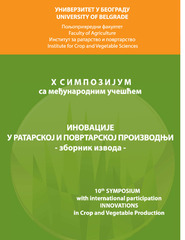Приказ основних података о документу
Perspective of wheat breeding
| dc.creator | Knežević, Desimir | |
| dc.creator | Paunović, Aleksandar | |
| dc.creator | Branković, Gordana | |
| dc.creator | Živić, Jelica | |
| dc.creator | Roljević Nikolić, Svetlana | |
| dc.creator | Mićanović, Danica | |
| dc.creator | Dolijanović, Željko | |
| dc.date.accessioned | 2023-12-18T11:03:53Z | |
| dc.date.available | 2023-12-18T11:03:53Z | |
| dc.date.issued | 2021 | |
| dc.identifier.isbn | 978-86-7834-383-4 | |
| dc.identifier.uri | http://aspace.agrif.bg.ac.rs/handle/123456789/6612 | |
| dc.description.abstract | Wheat is an important cereal species which use for production of food products, alcoholic beverages, pharmaceutical products, biofuels. Wheat seed is one of the most important source of protein as well as carbohydrate, fat, vitamins and mineral elements in food for human and nutrition. The evolutionary development of wheat is characterized by changes in morphological and anatomical characteristics, changes in the genome that are associated with adaptability to different environmental conditions and changes in biological and economic yield and quality traits. During the period from 10 thousand years ago until today, man, through his breeding work, and creating new genotypes, has influenced the changes in plant architecture, yield, quality and adaptability to biotic and abiotic conditions. The grain yields significantly increased in the 1960s and 1970s because farmers rapidly adopted the new varieties and cultivation methods of the so-called “green revolution”. Breeders have created and can create in the future new wheat genotypes with improved efficiency in the use of N, which will contribute to achieving higher and stable yields, better grain quality and environmental protection. Today, breeders have choice of two direction. In addition to this approach, today breeders create varieties with low content of storage proteins (gluten), with higher efficiency of nitrogen uptake, adapted to lower doses of nitrogen nutrition and higher efficiency of nitrogen uptake in order to reduce unused nitrogen and environmental protection. Modern biotechnological methods can contribute to the preservation and increase of genetic variability, more efficient breeding of varieties that are economical in production, with the desired technological and nutritional quality for the production of healthy food. | sr |
| dc.language.iso | en | sr |
| dc.publisher | University of Belgrade, Faculty of Agriculture, Serbia | sr |
| dc.rights | openAccess | sr |
| dc.rights.uri | https://creativecommons.org/licenses/by/4.0/ | |
| dc.source | X Симпозијум са међународним учешћем „Иновације у ратарској и повртарској производњи“ Београд, 21 – 22. октобар 2021. Зборник извода | sr |
| dc.subject | wheat | sr |
| dc.subject | breeding | sr |
| dc.subject | yield | sr |
| dc.subject | quality | sr |
| dc.subject | limitations | sr |
| dc.title | Perspective of wheat breeding | sr |
| dc.type | conferenceObject | sr |
| dc.rights.license | BY | sr |
| dc.citation.epage | 26 | |
| dc.citation.spage | 25 | |
| dc.identifier.fulltext | http://aspace.agrif.bg.ac.rs/bitstream/id/25191/bitstream_25191.pdf | |
| dc.identifier.rcub | https://hdl.handle.net/21.15107/rcub_agrospace_6612 | |
| dc.type.version | publishedVersion | sr |


